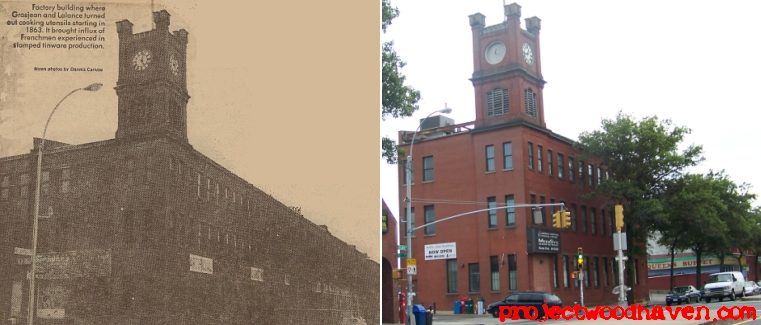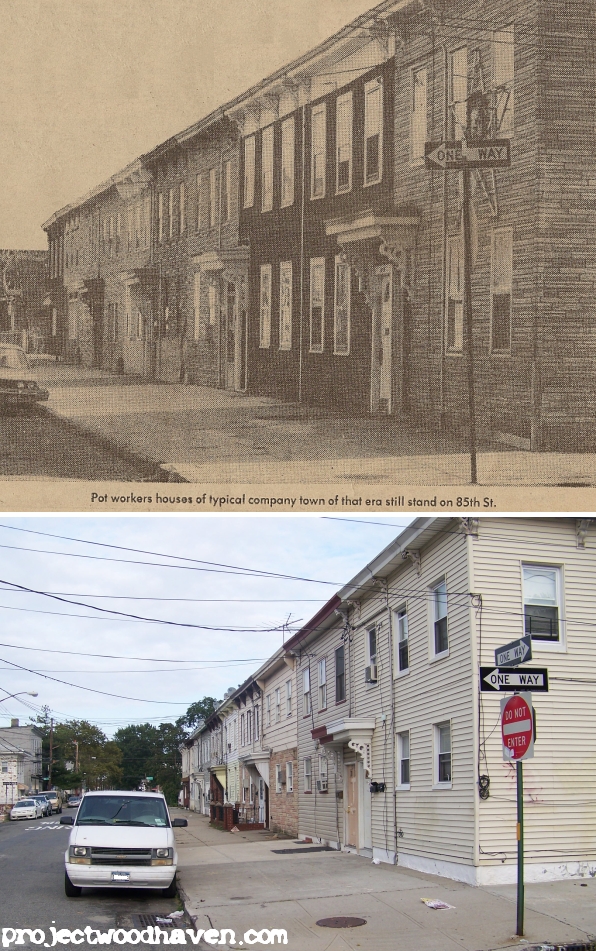




Here's another gem from the collection of Joe Virgona. In February of 1979 the New York Daily News ran an article detailing the history of "Old Woodhaven Village". It's an interesting look at this area, which is now considered part of Ozone Park, and its' part in the history of Woodhaven proper. Since the article is 30 years old, there is no online version -- so we've transcribed it. Another interesting thing about this article is its' use of then-contemporary pictures. We've taken current pictures of the same locations so that you get the 1979 view, side-by-side with the 2009 view . . . in an article about the 1800s! Be sure to follow the link at the bottom of this page to Part 2 of the story . . .
Old Woodhaven Village Built Around Pot Factory
February 11, 1979
written by William Neugebauer, photos by Dennis Caruso
copyright 1979 New York Daily News
The growth and development of Old Woodhaven Village, now a part of Ozone Park, ran parallel with that of a pots-and-pans factory and serves as a prime example of the "factory town" that heralded this country's emergency as the world's leading industrial power.
The expansion was said to have begun in 1863, when the Lalance and Grosjean stamped-tin factory began operations in an old chisel factory building on a site bordered by what are now Atlantic and 95th Aves. and 91st and 92nd Sts. It was during an era when the American hardware market was dominated by manufactured goods from Europe.

Florian Grosjean and Charles Lalance opened a business in 1850 in New York City, importing sheet metal and cooking utensils. Struck with the possibility of manufacturing similar goods in the United States, they established a pioneer plant in Manhattan. Business prospered so much that they needed larger quarters, and they came to Woodhaven Village in 1860.
Single Piece Stamping
The two men specialized in metal kitchenware and housewares that could be stamped out of tin and iron sheets in a single piece. An 1890 catalog includes spoons and forks, plates, kettles, milk cans, lanterns, pails, washstand sets and candlesticks, among other items.
Grosjean, who was thought to be Swiss, apparently induced a number of Frenchmen experienced in stamped tinware production to locate in Woodhaven. Historians say this settlement of craftsmen brought about a sizable French-speaking population that augmented the village's rather sparse population.
Shortly after the factory began operations, Grosjean began building about 100 workers' houses on land he had purchased close to the plant. A row of these two-story flat-roofed buildings stands today at numbers 85-02 through 85-20 95th Avenue.

As the factory grew, so did the community. Hotels, shops, churches and a market sprang up in the community with the expanding factory serving as the hub of the village.
In 1876, a fire devastated all but one of the wooden buildings, but the courageous owners promptly rebuilt and expanded the plant even more so that by 1882 the pot factory regularly employed 500 workers.
Suddenly 6,000!
At the time, the village of Woodhaven comprised about 175 houses with a population of 1,222. Eleven years later the population had soared to 6,000.
At the peak of its growth in 1899, the factory boosted the number of its' employees from 1,300 to 2,100, thus triggering the largest expansion of the village's population. At the same time, large estates in the village began to flourish and loomed as showplaces near a thriving shopping district.
In the 1920s, however, changes in Lalance and Grosjean's production line brought corresponding shifts in the local population, with employees moving to less crowded areas farther east as the workers' "colony" began to disintegrate.
The firm produced stainless steel for the Navy during World War II, reverted to production of its' Crusader Ware line after the war and went out of business in 1955, although most of the old factory complex remains in use today.
In it's forthcoming book, "Old Woodhaven, a Victorian Village" the Queens Historical Society observes:
"One must not dismiss the old brick buildings as merely another old industrial complex. In the case of Woodhaven Village, the factory is the only reason for the development of the area during the Victorian period. It was the heart of a thriving, hopeful, industrious community . . ."
Click here for the original Daily News article.
If you have any comments, or would like to suggest other projects, drop us a line at info@projectwoodhaven.com or projectwoodhaven@aol.com.
Return to Project Woodhaven's Home Page